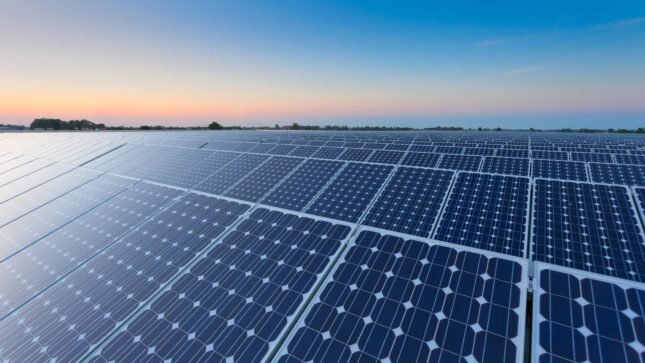Australia’s energy landscape is undergoing a profound transformation, and at the forefront of this change is solar power. Blessed with an abundance of sunshine, Australia has become a global leader in harvesting solar energy, contributing significantly to the rise of renewable energy sources within the country. As you explore the potential of clean power, you’ll find that the solar industry not only represents an environmentally friendly alternative but also stands as a beacon of innovation and economic opportunity.
With more than 3.5 million rooftop solar installations dotting the continent, solar energy now accounts for a considerable portion of Australia’s total electricity generation. This surge is a testament to the viability and appeal of solar as a sustainable energy choice. The fact that solar power can simultaneously drive down energy bills and reduce carbon footprints is propelling the nation towards a greener and more cost-effective future.
The importance of solar energy is further evidenced by the development of cutting-edge technologies by Australian companies, revolutionising how solar power is delivered and managed. Innovations in solar solutions not only contribute to greater energy equity but also solidify Australia’s position as a renewable energy powerhouse. As you consider your energy options, it’s clear that solar power is not just an alternative but is increasingly becoming the preferred solution for a sustainable and prosperous Australia.
The State of Solar Power in Australia
Australia’s solar energy sector is rapidly expanding, reshaping how you consume and generate electricity. With significant growth in installations and influence on the National Electricity Market (NEM), solar power is having a profound impact on traditional energy industries.
Growth of Solar Installations
Australian homes and businesses are adopting solar energy at an impressive rate. Recent figures show that the country boasts nearly 3.69 million solar PV installations with a capacity of over 34.2 GW. The majority of this capacity comes from rooftop solar systems that harness the sun’s energy for direct use in homes, leading to a surge in small-scale solar capacity. This volume of solar photovoltaic (PV) installations indicates the strong demand among Australians for renewable electricity solutions.
Solar Power and the National Electricity Market
Solar PV systems are becoming an integral part of the National Electricity Market (NEM). Managed by the Australian Energy Market Operator (AEMO), the NEM is witnessing a shift as solar energy contributes more to the electricity grid. In fact, the injection of solar power into the market is an example of the diversification of energy sources, which is crucial for the reliability and sustainability of your electricity supply.
Impact on Traditional Energy Industries
The rise of solar power is compelling traditional energy industries to adapt. As solar PV technology becomes more prevalent and cost-effective, more Australians are choosing solar energy resources over conventional energy sources. This trend is expected to continue, with solar power on track to account for a large amount of the country’s electricity generation by 2030. These developments signify a transformative period for the energy industry, with megawatts of solar capacity gradually displacing older, less environmentally friendly power generation methods.
Technological Advances in Solar Energy
Recent advancements in solar technology are making solar power more efficient and cost-effective, contributing significantly to Australia’s renewable energy landscape.
Photovoltaic Cell Innovations
In the realm of photovoltaic cells, there has been substantial progress, particularly with the development of perovskite solar cells. These cells have shown a rapid increase in efficiency, potentially surpassing traditional silicon cells. The efficiency milestone of 25.5 per cent was achieved much faster in perovskites than ever recorded in silicon, indicating a promising future for these materials in converting sunlight to electricity.
Battery Storage Solutions
Your solar power system’s effectiveness is directly tied to its ability to store energy. Advances in battery storage technology are stepping up, with home batteries becoming more compact and powerful. The integration of these batteries into solar systems allows for greater control over your generated energy, using it as needed rather than solely when it’s produced, which is a game-changing innovation for homeowners across Australia.
Solar Thermal Systems
The progress in solar thermal technology hasn’t been left behind. Solar thermal systems concentrate sunlight to heat a fluid, which is then used to generate electricity or for heating purposes. This technology is now more efficient, with advancements making it possible to harness the sun’s power even when it isn’t shining, thus providing a consistent and sustainable source of energy.
By embracing these technological advances in your solar energy system, you can be part of Australia’s energy revolution, contributing to a more sustainable and efficient future.
Economic Implications and Investments
In the rapidly changing landscape of Australia’s energy sector, your understanding of the economic implications and investments in solar power is essential. Solar energy not only offers a cleaner alternative but brings significant commercial and employment opportunities.
The Cost of Solar Energy
The cost of solar energy in Australia has seen a dramatic reduction. This is due, in part, to government incentives and the increasing affordability of rooftop solar systems. Your investment in solar power is now more cost-effective than ever, providing a viable alternative to traditional energy sources within the Australian market.
Investment in Solar Infrastructure
For you, the significant investment in large-scale power generation and solar infrastructure represents a commitment to a sustainable future. In 2022, there was nearly a 50 per cent growth in solar and wind farm investment commitments. Large-scale projects and the construction of new solar infrastructure are setting the stage for a green hydrogen economy.
Employment and Manufacturing Opportunities
Your interest in solar power is driving job creation in sectors such as construction, maintenance, and manufacturing. With Australia leading the world in rooftop solar installations, domestic manufacturing of solar components is set to expand. This surge represents not only commercial opportunities but also an increase in skilled and technical jobs within the renewables industry.
Environmental Impact and Climate Change
Australia’s pivot to solar power marks a significant stride in addressing climate change and reining in greenhouse gas emissions. Recognising the urgency, the shift to clean energy, particularly solar, is at the forefront of energy policy, aiming to decarbonise the nation’s energy grid and achieve net-zero emission targets.
Reduction of Greenhouse Gas Emissions
The adoption of solar power in your daily life plays a critical role in reducing greenhouse gas emissions. As solar panels convert sunlight into electricity without burning fossil fuels, this translates to less carbon dioxide and other harmful substances being released into the atmosphere. The Clean Energy Regulator indicates a substantial drop in emissions from electricity as more households and businesses go solar, actively confronting climate change.
Transitioning Away from Fossil Fuels
Your switch to solar energy is a direct action in the global need to transition away from fossil fuels. By choosing solar panels installed by companies like Solar Repairs, you contribute to decreasing Australia’s reliance on coal and natural gas. This shift is pivotal, given that the electricity sector has been historically dominated by fossil fuels, which are the primary source of greenhouse gas emissions.
Achieving Net-Zero Emissions Targets
To reach net-zero emissions, it is vital that you join efforts to maximise the use of renewable sources like solar power. Policies focused on emissions reduction and hitting renewable energy targets encourage systemic change. Your participation in adopting solar technology not only aids in achieving Australia’s net-zero goals but also propels the nation toward a sustainable and environmentally sound future.
Policy and Government Support
The Australian government’s commitment to solar energy is evident through robust policies and substantial financial support. Here’s how you can benefit.
Incentives and Feed-in Tariffs
When you invest in solar power, the federal government offers incentives to lower installation costs. The Small-scale Renewable Energy Scheme, for example, provides you with Small-scale Technology Certificates (STCs), which you can sell to recoup a portion of your costs. Moreover, certain states offer feed-in tariffs, allowing you to earn money for excess electricity that your solar panels feed back into the grid. This ensures that your investment in solar not only contributes to a cleaner environment but also gives back to your wallet.
Renewable Energy Zones and Community Batteries
To further boost solar power adoption, the government is establishing Renewable Energy Zones (REZs). These zones are areas identified for their high potential in renewable energy generation and are backed by infrastructure investments to facilitate the development of large-scale projects. Within these zones, community batteries are gaining traction. They store surplus power generated by local solar systems, providing stability and support to the energy grid. As part of the Powering Australia plan, these initiatives are designed to catalyse community participation and enhance Australia’s renewable energy landscape.
How Solar Repairs Can Help You in Perth
In Perth, your solar power system is a vital component of your household’s renewable energy solution. Given the city’s abundant sunshine, it’s important to ensure your solar panels, inverters, and related equipment are functioning efficiently. Solar repairs in Perth can significantly support the longevity and effectiveness of your rooftop solar system.
Timely Maintenance: By addressing repairs swiftly, you prevent minor issues from escalating into more significant, costly problems. Regular maintenance checks are crucial, and specialists like those at Solar Repairs Perth can help diagnose and rectify any faults before they affect your system’s output.
Quality Servicing: Professional repair services use state-of-the-art diagnostic equipment to troubleshoot and repair your system. Technicians are well-trained in managing all facets of solar repairs, from inverter malfunctions to panel issues.
Brand Versatility: Whether you’re sporting a common solar brand or a less familiar one, services such as Solar Repairs are equipped to handle a wide array of brands and models ensuring your repair needs are met, no matter your system.
Renewed Efficiency: Proper repairs can restore your system to its near-original efficiency. Companies like Solar Repairs emphasise the importance of regular inverter checks to maintain system performance.
Long-Term Savings: While there’s an upfront cost to solar repairs, the investment can mean significant savings in the long run. A well-maintained solar system operates at peak efficiency, reduces your energy bills, and can extend the life span of your solar installation.
Frequently Asked Questions
How is solar power contributing to Australia’s renewable energy targets?
Solar power is a cornerstone of Australia’s strategy to achieve renewable energy targets, with significant investment in both residential and large-scale solar projects. This expansion is pivotal in shifting the nation towards a cleaner energy future.
What are the environmental impacts of solar farm developments in Australia?
Solar farms play a vital role in reducing greenhouse gas emissions, but they also raise concerns about land use and habitat disruption. Careful consideration and planning are essential to minimise the environmental footprint of these developments.
How does the efficiency of solar panels in Australia compare to traditional energy sources?
Australia’s solar panels are becoming increasingly efficient, offering a clean alternative to traditional fossil fuels. Despite variable efficiency rates, solar technology improvements continue to enhance their capacity to generate electricity.
What advancements in solar technology are currently being developed in Australia?
Researchers in Australia are at the forefront of solar innovation, working on advancements that include more efficient photovoltaic cells and battery storage solutions. These developments aim to improve the reliability and efficiency of solar power systems.
How does the cost of solar energy compare to traditional energy sources in Australia?
Solar energy costs have dropped significantly, and when compared to traditional energy sources, they increasingly offer a cost-effective solution for homeowners and businesses alike. The declining cost of solar technology continues to improve its competitiveness.
What government initiatives support the adoption of solar energy in Australian households and businesses?
The Australian government has introduced various initiatives, including financial subsidies and feed-in tariffs, to encourage the uptake of solar energy. These incentives are designed to lower the barriers to entry and accelerate the adoption of solar technology across the nation.




